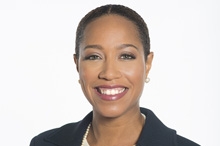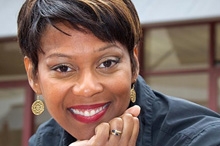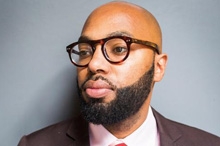Champions of Change Blog
Using STEM to Grow Strong Children
Posted by on March 5, 2014 at 3:21 PM EDT
Dr. Reagan Flowers is being honored as an African American STEM Champion of Change.
My passion and drive for helping children learn and succeed runs deep. As a child I failed the second grade and was, unfortunately, labeled a slow learner. Since education wasn’t reinforced in my broken home I was simply promoted from one grade level to the next one without acquiring basic skills. Subsequently, I was moved to a small town in Mississippi and attended a rural school where, for the first time, teachers invested in me personally and made me feel like I could achieve. I was a fifth grader when I started that school, but I’d never learned to multiply. With the support and guidance of several caring teachers I began to thrive as a student, and during my sixth grade school year I’d made the honor roll and was even becoming a math wiz! Thus, my calling to help other children rise above their challenges began.
I started my career as a science teacher at Jack Yates High School in Houston, Texas. In an effort to give my students hands-on experiences with real world problems, I enrolled them in a national robotics competition. Those students, who were of mixed performance levels on campus, had no prior robotics experience nor had they been placed in such a competitive environment. My students were initially intimidated and doubtful about the competition. However, the group outperformed everyone’s expectations. While their performance in the competition was encouraging, it was also very humbling because I saw first-hand the stark reality of the vast academic achievement gap between my students and their peers from other schools. This experience caused me to take up a new mission: closing the academic achievement gap.
In 2002, I founded C-STEM (Communication-Science-Technology-Engineering-Mathematics) Teacher & Student Support Services, Inc, the first integrated Pre K through 12th grade STEM enrichment program in the nation. The distinguishing factors of C-STEM Pedagogy and research model include: integrating communications (literacy) in STEM to ensure students can read, comprehend, write, and articulate solutions to math and science problems; implementing a curriculum influenced by STEM industries; developing a unique collaborative model that creates Pre K -12th grade pipelines; supporting interdisciplinary teacher teams through training and supplemental workshops; providing schools with innovative STEM instructional tools and resources; and developing competitive environments that support high performance and accountability for both teachers and students. In implementing C-STEM I have found teachers to be more effective in the classroom with connecting state approved curriculum to the real-world, which allows students to think critically and problem-solve. I find that C-STEM students are particularly drawn to the program because it helps them understand how STEM applies to their life and the world.
It is imperative that our schools remain leading authorities in STEM education worldwide. To accomplish this, educators must have adequate training, funding, and partnerships that aid in their development and leadership. This enables teachers to continue to inspire innovation, creativity, and exploration with their students. In my efforts I’ve also recognized that economic development in STEM is instrumental to future innovations. This is why my STEM approach provides support and services aimed at creating and sustaining STEM learning environments that are inclusive, equitable and level the playing field for the underserved and underrepresented. Children cannot dream or become that which they have not been exposed to, which is why opportunities provided by C-STEM create unlimited possibilities in communities across the United States.
Since founding C-STEM Teacher and Student Support Services, Inc. in 2002, the organization has grown from 20 students working out of the janitor’s workspace in a school building to impacting over 100,000 students. I have great success stories of students impacted by C-STEM that have completed college, are currently working as STEM professionals, volunteer with C-STEM, train teachers, mentor students and donate to support the organization that supported them. Their success and my triumph is proof that every student has potential and promise. At C-STEM, “Everyone is an Artist and an Engineer”.
Dr. Reagan Flowers is the founder of C-STEM, the nation’s first integrated STEM enrichment program for Pre K through 12th grade.
Learn more about TechnologyTurning Children Into Agents of Change
Posted by on March 5, 2014 at 3:06 PM EDT
Kimberly A. Scott is being honored as an African American STEM Champion of Change.
I have always believed that all children can innovate and be change agents if provided the proper resources and learning environment.
This vision means collaborating with those individuals who are underserved – through race, ethnicity, gender, poverty, – so that they can access and master the technological tools to further our communities. Creating an educational setting that values students’ identities and cultures is key in this digital age.
CompuGirls engages young girls from the ages of thirteen to eighteen in the digital world. By learning how to research and innovate with technology, girls increase their computational thinking and techno-social analytical skills.
I developed this program through my work at Arizona State University as Associate Professor of Women and Gender studies in the School of Social Transformation when it became increasingly clear to me that girls and young women from underrepresented communities are not entering or persisting in one of the most lucrative and stable careers—technology.
Consider that a new analysis of test-taking data recently reported in Education Week found that no female, African American, or Hispanic students took the Advanced Placement exam in computer science in Mississippi and Montana. Overall, of the 30,000 students who took the exam last year, less than 20 percent of those students were female. A 2012 study by the National Center for Women and Information Technology reported that only 3% and 1% of the United States computing workforce are African American and Hispanic women, respectively. Native American women majoring in computer and information sciences represent less than 1%. Yet, many girls belonging to these racial and ethnic groups are very interested in technology. Sadly, too many of the offered courses and activities are culturally irrelevant causing these prospective technologists to ultimately find the discipline boring. The persistent absence of these indivdiuals can lead to costly consequences for our society.
Since it began in 2007, CompuGirls has expanded from the Phoenix metropolitan area to Colorado, educating girls about social problems and nurturing skills they can use now and in the future. Girls in the program identify and research a social or community issue that is important to them, analyze the issue and ultimately come up with and present a solution. In this way, the technology becomes a means to the research. By using a peer mentoring approach, CompuGirls creates connections that support lifelong skill development in an empowering, creative and fun environment.
Being named a STEM Access Champion of Change is not only a distinct honor in my career, but also an acknowledgement of the need to teach girls technological skills in an engaging and transformative way, that will, in turn, add intellectual diversity and talent to our country’s workforce.
Kimberly A. Scott is the founder of CompuGirls, Associate Professor of Women and Gender studies in the School of Social Transformation at Arizona State University and Affiliate Faculty in George Mason University’s Center for Digital Media Innovation and Diversity. In addition to publishing in refereed journals, writing op-ed pieces, technical reports, book chapters and pieces for the Huffington Post, Scott is co-author of Kids in Context (2005, Rowman and Littlefield), and co-editor of Research in Urban Educational Settings: Lessons Learned and Implications for Future Practice (2011, IAP).
Learn more about TechnologyInspiring Future Scientists & Engineers One Kid at a Time
Posted by on March 5, 2014 at 2:51 PM EDT
Andrea Hence Evans is being honored as an African American STEM Champion of Change.
As a child, I looked forward to my school’s science fair each year. I couldn’t wait to put on my lab coat and my safety glasses. After all, I wanted to look the part. I would proudly march into the Houston Community College’s science lab with my sharpened pencil and lab notebook ready to conduct my experiment. The College’s science professor would supervise me as I would carefully follow the scientific method. I was anxious to create my science fair board because I wanted to share my results with my peers. My family knew the importance of exposing me to science, technology, engineering and math (STEM) at an early age. Unfortunately, many parents are not knowledgeable about the important role they play in peaking their children’s interest in STEM education and careers. Or, many parents do not have access to resources available to get their children the necessary exposure. My science fair experience had a profound impact on me and I attribute my hands-on science fair experience as one of the reasons I pursued and obtained degrees in Math and Civil and Environmental Engineering degrees at Spelman College and Georgia Institute of Technology, respectively. Studies show that STEM college students were inspired to study STEM subjects because of a teacher or class.
Studies also show that by the third grade, children have permanently lost their interest in math and science. At as early as eight years old, a student is already using the dreaded “B” word and science in the same sentence. The “B” word is every parent and teacher’s least favorite word…BORING! When my daughter reached kindergarten, I searched for an exciting and fun STEM class that would engage and stimulate her. I learned that there were several STEM classes for middle school and high school students, but I was worried that if my daughter was not enthusiastic about STEM before eight years old, there would be a slim chance of her regaining interest. Thus, in 2009, I launched KIDGINEER, LLC to inspire students to excel in science, technology, engineering, and math.
KidGINEER® is a creative and fun STEM enrichment program targeting students ages five to ten years old. The program is divided into six week sessions and we focus on exposing the students to all disciplines of engineering such as civil, mechanical, chemical, computer and electrical engineering, for example. At the end of each session, we invite an engineer to speak to our students about their roles and duties as it relates to the subject matter the students have learned for the session. Students as young as five years old have built robots that have sensors that react to motion and these students can effectively communicate the science behind their robots. I truly enjoy working with elementary students to expose and help inspire them to consider careers in science and engineering. It is always a heartfelt moment to see the immense joy on our students’ faces as they see their first robot work or wire their fans, doorbells, and ceiling fans in their personalized miniature houses. Our young students are more inspired to seek out STEM programs in middle and high school and they are more likely to pursue a career in a STEM field because of this early exposure. It is important that we provide our future generations with the capability to continue to lead the world. In a knowledge-based global economy, this means ensuring that our country can ‘out invent and out innovate’ other countries around the world. We owe our children this opportunity and I am proud that I can make a positive impact on them. Lastly, I am truly grateful to be recognized by The White House as a STEM Access Champion of Change!
Andrea Hence Evans is the Principal of KidGINEER, LLC, a STEM enrichment program in the Washington DC area. She is also the owner of an intellectual property law firm, The Law Firm of Andrea Hence Evans, LLC.
Learn more about TechnologyFull S.T.E.A.M. ahead in Urban Science Education
Posted by on March 5, 2014 at 2:36 PM EDT
Dr. Christopher Emdin is being honored as an African American STEM Champion of Change.
Over the last few years, I have had the opportunity to visit hundreds of science classrooms. Many of them have been in the most socioeconomically challenged communities in the United States. These are communities where incarceration rates are high, graduation rates are low, and young people are so preoccupied with making it through each day that they view dreaming about a better future as a luxury they cannot afford. Like their students, educators who work within these communities are so preoccupied with the basic daily operation of schools that they see the work of creating the next generation of scientists as a luxury they cannot afford. In these communities - where seemingly insurmountable everyday challenges threaten possibilities for the future, thinking about the future or paths towards improving it are perceived as a foolhardy exercise. Oftentimes, this means that engaging students in science, technology, engineering and mathematics (STEM) is perceived as a hindrance to surviving the immediate and ever evolving everyday challenges/requirements of urban teaching.
There is a culture of immediacy that permeates many urban schools that makes it challenging for teachers to engage deeply in STEM. This culture is driven by the fact that these schools are mandated to look and sound exactly like what many consider to be the best schools - that are geographically and culturally far away from urban America. This expectation to be like the “best schools” plays out as a never-ending set of rules and expectations in urban schools that is intended to force them to have the same test results and graduation rates as schools with very different ethnic, racial, and cultural compositions. While the expectation of similar results is a necessary one, we fail to recognize that the path towards those results must look different in different schools.
If education in the most under-resourced communities becomes driven by how closely these schools can follow new mandates, shifting curriculum, and ever-evolving guidelines, educators become bound by the chase of trying to do all they are asked. They become so preoccupied with this process that they do not have the space or time to think deeply about new approaches to teaching and learning that will turn their students on to STEM careers.
As urban schools grapple with following the approaches to teaching implemented in other communities, and as they attempt to follow the cultural guidelines that are the norm in other schools, they do not have the space to focus on approaches to teaching STEM that are best for their students. Concurrently, schools who are not expected to shift their practice every new school year, and who do not have to teach any differently than they always have, continue to prepare their students for STEM careers successfully. This results in the persistent achievement gaps between schools that serve affluent culturally monolithic populations and diverse urban schools that primarily serve youth of color. In turn, these achievement gaps create a sense of alarm that results in more mandates and guidelines in communities that actually need less restriction so they can meet the unique needs of their students. As long as we expect all schools to be the same while schools that underperform are not allowed to truly engage their students, students in these schools will continue to see STEM as something for “other students” from “other neighborhoods” with “other family structures.”
Currently, STEM is seen as a set of subjects for the “best and brightest.” Historically, the best and brightest have been those with the most stable school and family structures with modes of instruction that are culturally aligned to their everyday experiences. Furthermore, the toughest or the most resilient have not been seen as being able to be a part of the best and brightest. My work challenges this history and fights the notion that students’ circumstances are an accurate tool for defining their potential academic success.
I suggest that engaging populations that are least represented in STEM requires that the classroom be malleable enough to allow the students’ unique art and culture to drive the instruction. This does not mean that we sacrifice high expectations or are less rigorous. It does mean that teaching styles must be unique to each school, and STEM instruction must be reflective of the arts and culture in the community of the school.
Incorporating the arts into STEM is part of a growing international movement called STEAM (science, technology, engineering, arts and mathematics). This approach requires that schools work with teachers to incorporate youth art and culture into the teaching, and the quality of instruction is based on how well the art and culture of the student is included in the teaching, and not on how close the urban school follows the pattern of schools in other communities. To STEAM ahead means that we use the arts to allow young people to see themselves in STEM. It validates youth who write raps about science, allows spoken word poetry about engineering concepts, and welcomes social media as a platform for sharing STEM news with youth. Moving full STEAM ahead considers motivating youth to participate, and building their self-confidence as the first two steps in preparing them for STEM careers. Most importantly, it considers the cultural art forms that youth engage in outside of the classroom as the pathways to introducing them to STEM disciplines and careers.
As a trained research scientist, I recognize the hard work required to fully engage in STEM. I have experienced the effort it takes to gain a command of the complex mathematical knowledge required to do my work. I have had to work hard to develop the skill to create and manipulate technology so I could conduct my research. I have experienced the attention to detail required to construct and test complex engineering models. However, I also realize that young people whose schools don’t allow them to see themselves as a part of STEM will never get to the point where they can appreciate the wonder and beauty of STEM.
Many say that it is easy to grab the attention of just about any child when they are introduced to a cool chemistry experiment or the physics of roller coasters. I respond by saying that in many urban schools populated by youth of color, the school is so preoccupied with trying to make students shed their culture that there is no space for innovative pedagogy that includes cool experiments and real life examples. In many schools, educators are so busy following scripts that they have no space to truly do STEM. As a result, students are so disengaged in STEM by the time they reach high school that the first time they are challenged academically, there is no passion in place to help them to overcome the academic struggle.
How is it possible that a student who is resilient enough to overcome missing meals, a broken family, and tough everyday circumstances cannot overcome the rigors of an introduction level STEM course? The answer lies in the absence of a motivation to engage. If the cultural connection to the discipline is non-existent, and the education that is being received does not ignite the passion of the student, we will not create STEM professionals. To increase access to STEM for all students, we must move full STEAM ahead. I am honored to be acknowledged by the White house for promoting this approach.
Christopher Emdin, Ph.D is an Associate Professor of Science Education at Teachers College, Columbia University, where he also serves as Director of Science Education at the Center for Health Equity and Urban Science Education.
Learn more about TechnologyUsing STEM to Create the Future You Want to See
Posted by on March 5, 2014 at 2:21 PM EDT
Kevin Clark is being honored as an African American STEM Champion of Change.
I am humbled and appreciative to be selected as a White House STEM Access Champion of Change for my work to support and accelerate STEM opportunities for African American students, schools, and communities. I believe STEM education has the potential to improve the educational opportunities for students who are traditionally underserved, but the mere presence of STEM resources are not enough. African Americans watch the most television and spend the most time playing video games, yet a persistent achievement gap still exists. STEM resources have the most educational impact when they are used to accomplish specific tasks and solve relevant problems.
As I think about my own STEM education, I was motivated more by not wanting to incur the wrath of my grandmother if I brought home poor grades, rather than by my high school curriculum. It wasn’t until I took my first programming class in high school that I became interested and engaged in STEM content; even if it did start with figuring out how to move a computerized turtle from one end of the screen to the other.
My STEM journey continued as I majored in computer science in college, then it took a fortuitous turn when I left graduate school to work for an educational software start-up company. It was during this time that I realized the value of my STEM education and how it could be applied to the creative design and development educational software and video games. I continue to draw form that experience and knowledge as I consult and advise arts groups, the National Parks Service, museums, and children’s media organizations on issues of diversity and the effective utilization of STEM resources.
After leaving the corporate sector for higher education, I established the Center for Digital Media Innovation and Diversity (CDMID) at George Mason University to examine issues of diversity in digital media and broadening participation in STEM disciplines and careers. The STEM For All project epitomizes CDMID’s collaborative goals by convening diverse groups of researchers, practitioners, funding organizations, and policy analysts with interest, expertise, and knowledge in positively affecting the STEM participation and opportunities of traditionally underserved students.
Another CDMID project, involved the development of a mentoring model that taught middle and high school students how to work in collaborative groups to create educational video games using STEM content. Students who consistently participated in the program showed increased confidence in their math and science abilities, which was also reflected in the improved grades they reported. Although students became engaged and motivated to create STEM-themed educational video games, many of them did not know how to achieve their newly realized dream of becoming a computer programmer, graphic artist, engineer, etc.
Students and families who begin exploring STEM pathways and learning opportunities early allow for more educational options and possibilities. The HFB STEM project provides opportunities for elementary school students to engage in robotics and technology workshops during and after-school, and for their parents to participate in academic planning workshops and information sessions.
STEM education is not a panacea, but traditionally underserved communities can use STEM skills to design digital media that captures their stories and perspectives, and equips them with the skills and knowledge to be competitive in the global economy.
Kevin Clark is a professor in the division of learning technologies in the College of Education and Human Development at George Mason University. He is also the founder and director of the Center for Digital Media Innovation and Diversity.
Learn more about Education, TechnologyChampions of Change: Women Veteran Leaders
Posted by on February 24, 2014 at 1:17 PM EDTWomen serve in every branch of the military, representing 14.5 percent of today’s active duty military and nearly 18 percent of National Guard and Reserve forces. By 2020, the Department of Veterans Affairs estimates women Veterans will constitute more than 12 percent of the Veteran population.
Officially, women were permitted to service in the military in 1901. Their service introduced America to a new era of military service and subsequently, women Veterans. For generations now, women Veterans have been honorably serving in the military, and we know their service and success continue when they take off the uniform.
As the nation celebrates Women’s History Month, it is important to salute women Veterans for their accomplishments and contributions to society. They have broken barriers and capitalized on the many leadership opportunities afforded by military service. We know that women Veterans are models of character, courage and commitment who continue to blaze trails and open doors.
This March, the White House Office of Public Engagement will host a Champions of Change event for women Veteran industry leaders, to highlight their incredible contributions to our nation’s business, public and community service sectors.
We are asking for your help to identify women Veterans who may be “Champions of Change.”
For example, a champion may be a woman Veteran who is:
- Serving as subject matter expert within her industry
- Actively mentoring to enable others’ success
- A successful entrepreneur and/or businesswoman
- Leading a program to improve the well-being of fellow Veterans
- A leader in government
- Demonstrating success with public/private partnering
Click on the link below to submit your nomination by midnight on Friday, February 28th (be sure to choose Women Veteran Leader in the "Theme of Service" field of the nomination form).
Nominate a Women Veteran Leader Champion of Change
We are looking forward to hosting this event and to highlighting the great work women veterans are doing across the country.
Elisa Basnight is the Director of the Center for Women Veterans at the U.S. Department of Veterans Affairs.
Learn more about Veterans
- &lsaquo previous
- …
- 31
- 32
- 33
- 34
- 35
- 36
- 37
- 38
- 39
- …
- next &rsaquo
White House Blogs
- The White House Blog
- Middle Class Task Force
- Council of Economic Advisers
- Council on Environmental Quality
- Council on Women and Girls
- Office of Intergovernmental Affairs
- Office of Management and Budget
- Office of Public Engagement
- Office of Science & Tech Policy
- Office of Urban Affairs
- Open Government
- Faith and Neighborhood Partnerships
- Social Innovation and Civic Participation
- US Trade Representative
- Office National Drug Control Policy
categories
- AIDS Policy
- Alaska
- Blueprint for an America Built to Last
- Budget
- Civil Rights
- Defense
- Disabilities
- Economy
- Education
- Energy and Environment
- Equal Pay
- Ethics
- Faith Based
- Fiscal Responsibility
- Foreign Policy
- Grab Bag
- Health Care
- Homeland Security
- Immigration
- Innovation Fellows
- Inside the White House
- Middle Class Security
- Open Government
- Poverty
- Rural
- Seniors and Social Security
- Service
- Social Innovation
- State of the Union
- Taxes
- Technology
- Urban Policy
- Veterans
- Violence Prevention
- White House Internships
- Women
- Working Families
- Additional Issues

